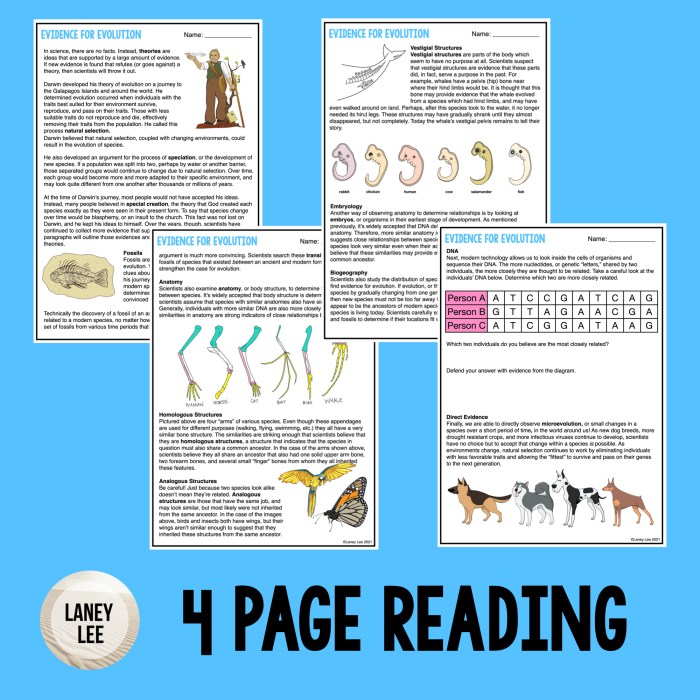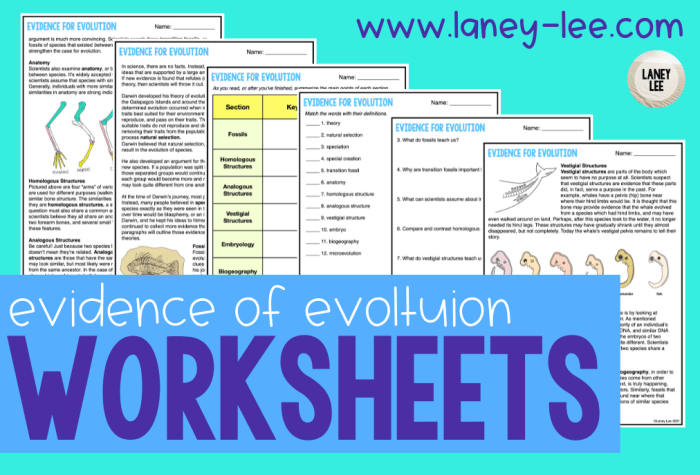Evidence for evolution worksheet answers – Embark on a scientific odyssey as we delve into the compelling evidence that unravels the tapestry of evolution. From the depths of the fossil record to the intricate dance of DNA, this exploration illuminates the remarkable journey of life’s transformation.
Prepare to witness the power of evidence as it paints a vivid portrait of evolutionary processes, revealing the interconnectedness of all living organisms and the grandeur of nature’s design.
Fossil Record
The fossil record provides compelling evidence for evolution by documenting the progression of species over geological time. Fossils preserve the remains or traces of organisms that lived in the past, offering a glimpse into the history of life on Earth.
Transitional Fossils
Transitional fossils are particularly significant in supporting evolutionary theory. They exhibit a combination of characteristics from two different groups, providing a link between ancestral and descendant species. For example, the fossil Archaeopteryx, a transitional species between reptiles and birds, displays features of both groups, including feathers and a bony tail.
Comparative Anatomy: Evidence For Evolution Worksheet Answers

Comparative anatomy examines the similarities and differences in the anatomical structures of different species. Homologous structures, such as the forelimbs of mammals, share a common evolutionary origin despite their variations in form and function. These similarities provide evidence for common ancestry.
Vestigial Structures, Evidence for evolution worksheet answers
Vestigial structures are remnants of ancestral structures that have lost their original function in certain species. For example, the human tailbone is a vestigial structure that is no longer used for locomotion, suggesting our evolutionary relationship with primates.
Molecular Biology

DNA and protein sequences provide powerful evidence for evolution. By comparing the genetic sequences of different species, scientists can determine their evolutionary relationships. Molecular clocks, based on the rate of DNA sequence change, allow researchers to estimate the time of divergence between species.
Common Descent
Molecular evidence strongly supports the theory of common descent. For example, all living organisms share a common genetic code, indicating that they evolved from a universal ancestor.
Biogeography
Biogeography studies the distribution of species across different regions. The presence of similar species in geographically isolated areas suggests common ancestry. For example, the marsupials of Australia and the placentals of other continents evolved from a common ancestor that existed before the continents separated.
Embryology

Embryological development provides insights into evolutionary relationships. The early stages of embryonic development in different species often exhibit striking similarities, suggesting a common evolutionary origin. For example, the embryos of vertebrates, including humans, all have a notochord, a flexible rod that supports the developing nervous system.
Direct Observation
Direct observation of evolutionary changes in species provides further evidence for evolution. For example, the peppered moth, Biston betularia, has evolved darker coloration in response to industrial pollution, demonstrating the rapid adaptation of species to changing environmental conditions.
Artificial Selection
Artificial selection, the selective breeding of organisms by humans, provides a powerful demonstration of the principles of evolution. By selecting for specific traits, humans can create new breeds of plants and animals with desired characteristics.
FAQ Explained
What is the significance of transitional fossils?
Transitional fossils provide crucial evidence for evolution by exhibiting intermediate forms between ancestral and descendant species, bridging the gaps in the fossil record.
How do homologous structures support evolutionary theory?
Homologous structures in different species share a common ancestry, indicating their descent from a common ancestor and providing evidence for the diversification of life.
What role does molecular biology play in understanding evolution?
Molecular biology analyzes DNA and protein sequences to reveal genetic similarities and differences, providing insights into evolutionary relationships and the common descent of species.